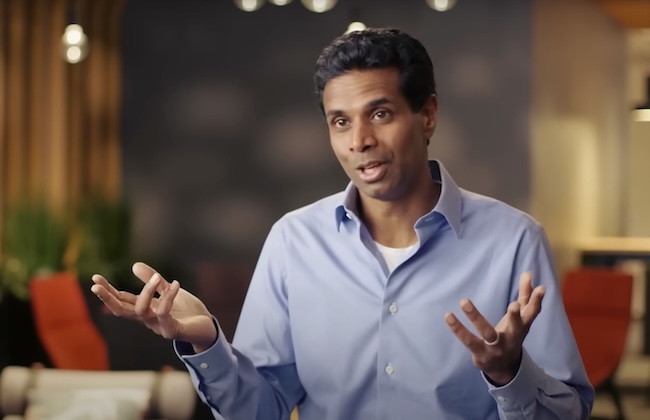Chetan Nayak Stars in the Biggest Drama in Quantum Computing
By Goldsea Staff | 19 Nov, 2025
Microsoft's next quantum chip release will decide whether Chetan Nayak's Majorana 1 chip is the most revolutionary breakthrough in quantum computing or one of the world's great scientific blunders.
An Indian American physics professor at UC Santa Barbara may prove to be the hero who brings reliable, scalable quantum computing to the world. Or he may be remembered as the villain who destroyed the world's faith in a nascent field of unimaginable importance to the advance of human civilization. The answer will likely have to wait for the successor to Microsoft's Majorana 1 chip.
Majorana zero states at opposing ends of a semiconducting nanowire form a topological qubit. (Image from Microsoft video)
No single quantum computing project has ignited as much fierce debate and edge-of-the-seat drama as Microsoft’s ambitious quest for the Majorana qubit, led by distinguished scientist Dr. Chetan Nayak. His work, culminating in the highly controversial unveiling of the "Majorana 1" chip in February 2025, didn't just push the boundaries of physics; it exposed deep rifts within the scientific community and sparked accusations, retractions, and a public battle for the soul of quantum computing itself.
A greatly enlarged view of topological qubits that combine to form the topological core of Microsoft's Majorana 1 quantum chip. (Image from Microsoft video)
To understand the magnitude of this drama we must understand why quantum computing is such a big deal, and why the "Majorana" concept is so revolutionary – and therefore, so contentious.The Promise of Quantum Computing: Beyond 0s and 1sOur everyday computers work with bits, which are like light switches that can be either ON (1) or OFF (0). Quantum computers, however, use "qubits." These aren't just light switches; they’re more like dimmers that can be ON, OFF, or a combination of both simultaneously — a phenomenon called superposition. Even weirder, qubits can be entangled, meaning they are linked in such a way that the state of one instantly affects the state of another, no matter how far apart they are.
These two quantum superpowers — superposition and entanglement — allow quantum computers to explore vastly more possibilities at once than even the most powerful superocmputers. This holds immense promise for solving problems currently intractable for classical machines, including:
• Drug Discovery: Simulating molecules and proteins with unprecedented accuracy
• Materials Science: Designing new materials with specific properties from scratch.
• Financial Modeling: Optimizing complex investment strategies.
• Cryptography: Breaking currently unbreakable codes (and creating new, secure ones).
The Fragile Nature of Qubits: The Challenge of Error
The catch is that qubits are incredibly fragile. Their delicate quantum states are easily disrupted by even the tiniest environmental noise – a stray magnetic field, a tiny vibration, or even a minuscule temperature fluctuation. This disruption, called decoherence, causes the qubit to lose its quantum information, leading to errors.
Building a truly powerful quantum computer requires thousands, even millions, of stable qubits. Protecting these qubits from errors is the single biggest challenge in the field. This is where the concept of the "Majorana qubit" enters the stage as it promises a radical solution.
Enter the Majorana: A Topological Shield Against Error
The "Majorana" that Chetan Nayak and Microsoft are chasing isn’t a fundamental particle like an electron. Instead, it’s a Majorana zero mode (MZM), a peculiar kind of "quasiparticle" that can emerge in specially designed materials, typically super-cooled semiconductor wires placed very close to superconductors.
The magic of MZMs for quantum computing lies in their topological protection. Imagine encoding information not in a single, fragile qubit, but in the collective behavior of two MZMs located at opposite ends of a wire. The quantum information isn't "on" either MZM individually; it's encoded in their intertwined, non-local relationship.
Visualize a knot in a rope. You can push and pull the rope, change its shape, but the knot itself remains the same unless you specifically untie it. Similarly, because the information in a topological qubit is spread out, local disturbances (noise) can't easily destroy it. You would need to literally "braid" the MZMs around each other to manipulate the information, and only by bringing them together and annihilating them could you truly lose it. This makes them theoretically far more robust and less prone to errors than conventional qubits.
This promise of "fault-tolerant" quantum computing — where errors are inherently suppressed by the laws of physics, rather than needing complex, external correction systems — is precisely why Microsoft made its big bet on the elusive Majoranas. Their chief architect of this daring venture is Chetan Nayak.
Nayak and Microsoft's High-Stakes Bet
Dr. Chetan Nayak is a Distinguished Scientist and Technical Fellow at Microsoft Quantum, and a leading theoretical physicist in the field of topological quantum computing. Under his guidance, Microsoft made the bold decision to focus almost exclusively on building quantum computers using topological qubits based on MZMs. This was a significant gamble because other major players like IBM and Google were pursuing different, more conventional (though still incredibly difficult) qubit technologies, such as superconducting circuits.
The challenge was immense: first, to definitively create and detect MZMs, and then to show they could be used to build a functional qubit. For years, experimental evidence for MZMs remained elusive, often leading to ambiguous results.
The 2018 Retraction: A Shadow of Doubt
The drama began brewing well before 2025. In 2018, a highly anticipated paper claiming to have detected MZMs, with Microsoft researchers as co-authors, was published. This was seen as a major step forward. However, just a year later, the paper was retracted. Independent re-analysis of the data, including previously omitted measurements, revealed that the signals attributed to MZMs could actually be explained by more conventional physics, such as disorder in the material.
This retraction was a significant blow, not just to Microsoft but to the entire field, highlighting the extreme difficulty and the rigorous scrutiny required for such a fundamental claim. It cast a long shadow, fueling skepticism among many physicists who questioned whether MZMs would ever be definitively observed, let alone harnessed for computing.
The "Majorana 1" Unveiling: February 2025
Fast forward to February 2025. After years of intense work and in the wake of past failures, Microsoft announced the "Majorana 1" chip, claiming it was the world's first quantum processor powered by a "Topological Core."17 The announcement was accompanied by a paper in the prestigious journal Nature, outlining the experimental results.18 This was it: Microsoft and Nayak were seemingly delivering on their grand promise.
The anticipation in the quantum community was palpable. Had they finally done it? Had Nayak’s team cracked the code and opened the door to truly fault-tolerant quantum computing?
The Blowback: Skepticism Erupts into Outright Hostility
Instead of universal acclaim, the announcement triggered an explosion of fierce skepticism and outright condemnation from a vocal segment of the physics community. The "Majorana 1" unveiling didn't end the debate; it supercharged it into the biggest drama the field had ever seen.
Key points of contention and criticism included:
The "Topological Gap Protocol (TGP)": Microsoft had developed a specific test, the TGP, to confirm the presence of MZMs.19 Critics, most notably physicist Henry Legg and Professor Sergey Frolov, argued vehemently that the TGP was flawed.20 They contended that it could produce "false positives"—signals that looked like MZMs but were actually generated by mundane physics, like "disorder" or "impurities" in the material.21
"Unconvincing Data" and "Noise": Many physicists who examined the Nature paper found the experimental data to be ambiguous. They argued that the critical signals indicating the presence of MZMs were weak, noisy, and difficult to distinguish from background fluctuations. Some critics went as far as to describe the signals as "incredibly unconvincing" and even "just noise."
The Nature Disclaimer: Damningly, the Nature paper itself included a statement from the editorial team clarifying that the results did not constitute direct evidence for the presence of Majorana zero modes.22This was a red flag that amplified the community's doubts.
Accusations of "Cherry-Picking" and "Fraud": The language used by some critics was unusually harsh for scientific discourse. Professor Frolov, a long-time player in the MZM hunt, publicly called the project "unreliable" and even a "fraudulent project." Others accused Microsoft of "gross cherry-picking" data to present a favorable narrative, echoing concerns from the 2018 retraction.23
Nayak's Defense: Standing Firm Amidst the Storm
As the leader of the project, Chetan Nayak found himself at the epicenter of this firestorm.24 He directly addressed the critics, most prominently at the American Physical Society (APS) meeting in March 2025.25
Dismissal of Critiques: Nayak dismissed the arguments of critics like Legg, calling their critiques a "false straw man" and a "non-issue."26 He staunchly defended Microsoft's methodology and the validity of the TGP.27
Acknowledgement of Difficulty: While defending the results, Nayak did acknowledge the difficulty in presenting the data for certain key measurements, admitting that signals were sometimes hard to discern due to electrical noise.28 This concession, however, did little to satisfy the most vocal critics.
"Never One Moment of Conviction": Nayak also recognized the inherent challenge of convincing the entire scientific community of such a groundbreaking claim. He stated that he "never felt like there would be one moment when everyone is fully convinced," framing the ongoing skepticism as a natural part of the scientific process for a high-risk, high-reward endeavor. He also pointed to progress made since the paper was submitted, promising further compelling evidence.29
Why This Drama Matters
The controversy surrounding Chetan Nayak and the Majorana chip is far more than just a scientific disagreement; it’s a high-stakes battle for:
Scientific Truth: At its core, it's about whether MZMs truly exist in these engineered systems and whether Microsoft's claims are rigorously supported by data. The integrity of scientific methodology and peer review is under intense scrutiny.
The Future of Quantum Computing: If topological qubits prove viable, Microsoft could have a significant advantage. If not, their massive investment might be misplaced, and the field might need to consolidate around other qubit technologies.
Public Trust: The drama impacts public and investor confidence in quantum computing as a whole.30Repeated claims and retractions, alongside heated public disputes, can make the field appear less credible.
The drama surrounding Chetan Nayak’s Majorana chip work has indeed generated the most dramatic and heated controversy in the commercial quantum computing sphere. It's a testament to the revolutionary potential, the immense technical challenges, and the passionate, sometimes unforgiving, nature of scientific progress at the very edge of human knowledge. The debate is far from over, and the quantum world watches with bated breath to see if Nayak and Microsoft will ultimately prove their skeptics wrong, or if the elusive Majorana will continue to be a source of scientific contention.

(Image from Microsoft video)
Asian American Success Stories
- The 130 Most Inspiring Asian Americans of All Time
- 12 Most Brilliant Asian Americans
- Greatest Asian American War Heroes
- Asian American Digital Pioneers
- New Asian American Imagemakers
- Asian American Innovators
- The 20 Most Inspiring Asian Sports Stars
- 5 Most Daring Asian Americans
- Surprising Superstars
- TV’s Hottest Asians
- 100 Greatest Asian American Entrepreneurs
- Asian American Wonder Women
- Greatest Asian American Rags-to-Riches Stories
- Notable Asian American Professionals

